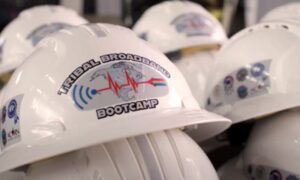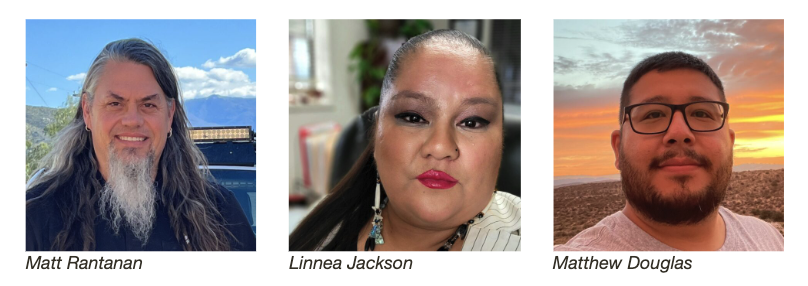- About
- Network
- Community
- Initiatives
- News
- Events
- Blog
- Publications

Tribal Broadband Connectivity: Obstacles, Opportunities, Optimism
Categories Equity & Access Tribal

In southern California, some of the broadband needs of Tribal communities have been addressed by a connection between the Tribal Digital Village Network (TDVNet) and the statewide fiber-based, high-performance CENIC backbone that provides TDVNet with extremely cost-effective backhaul connectivity. This connectivity allows TDVNet’s constituent networks to scale and supports Tribal communities with affordable solutions and connections to resources of education and innovation that they would not have access to with other carriers. However, major obstacles to dedicated Tribal broadband infrastructure still remain.
At CENIC’s 2022 Annual Conference, Tribal telecommunications experts Matthew “Speygee” Douglas, Linnea Jackson, and Matt Rantanen shed light on a few of these obstacles – what they are and how they complicate Tribal broadband deployments in California – and how progress has been made in the face of them. They also reminded attendees that these challenges may take on different aspects for the 574 federally recognized Tribes throughout the US.

Creating broadband infrastructure on sovereign Tribal land involves multiple levels of complex permitting.
Many people are aware of some issues surrounding construction on historically sensitive Tribal lands. Add to this the challenges of obtaining permits on what may also be environmentally sensitive land, national forest administered by the US Forest Service, or “off-Caltrans” areas where construction becomes more involved, and the term “shovel-ready” can assume unheard of layers of complexity.
A Way Forward: Wireless Extensions and Environmental Collaborations
This highlights the importance of wireless extensions for Tribal nations, given that much more localized and hence less construction is needed to install a tower or towers than to lay or suspend fiber-optic cable. Also, environmental sensitivity can sometimes be used as a lever to promote new infrastructure installations, joint builds, or sharing of space on existing installations used for scientific research, disaster response, or National Park Service activities.

Wireless spectrum licenses are not granular enough to complete last-mile or even last-yard connections on Tribal lands.
The active area of a typical wireless spectrum license is often not granular enough to accommodate use by both Tribes and large providers. For example, a large provider may purchase a wireless spectrum license for an entire county with the intent of using it only in the most densely populated urban areas of that county. Thus, the spectrum lies unused over remote, rural lands where Tribes are likely to live, but Tribes are unable to take advantage of it.
A Way Forward: Wireless Spectrum Carve-Outs and Licenses
Wireless spectrum “carve-outs” over Tribal land of active licenses held by large providers can play a crucial role in any last-mile or last-yard solutions for these Tribes. Also, in 2021 the Federal Communications Commission (FCC) recalled the 2.5GHz frequency band for auction. For the first time, 400 Tribes nationwide were able to obtain full-strength wireless spectrum licenses.
Obtaining funds for development on Tribal lands comes with unique issues due to their nature as sovereign land.
Obtaining loans often requires collateral: an asset that can be seized by banks in cases of default. Many entities who seek loans for any reason may offer brick-and-mortar assets as collateral. This becomes impossible on sovereign land, where such assets cannot be used as collateral because they cannot be repossessed. (This explains the popularity of mobile homes and businesses on Tribal lands, where permanent structures on sovereign land cannot be leveraged to obtain loans.)
A Way Forward: Wireless Licenses as Bankable Assets
With the acquisition of full-strength wireless spectrum licenses that can count as bankable assets, Tribes can more readily obtain loans toward infrastructure and other projects in addition to using the licenses for last-mile and last-yard circuits where wireless solutions are ideal. Without such assets, Tribes are constrained to state, federal, and other sources of funding that can come with restrictive or unpredictable timelines.

Most telecom equipment is not performance-tested in the types of environments where many Tribal communities reside.
Many Tribal communities reside in remote and rugged areas unlike the places where telecom equipment is often tested, benchmarked, and deployed. High winds or severe weather often cause service interruptions beyond what testing may have accounted for. Thus, these Tribes must carry out their own benchmarking on equipment unable to function as promised. To complicate matters, wireless extensions are often the only way to close last-mile and last-yard gaps, and wireless transmitters and receivers have trouble penetrating forested areas and throughput issues when mounted on swaying towers.
A Way Forward: Spectrum Bartering
Tribes can leverage the previously mentioned wireless spectrum licenses to work out trade deals with incumbent providers for different spectrum frequencies that may offer better signal penetration and distribution in areas with trees and other obstacles. For example, a 2.5GHz wireless spectrum license awarded to a Tribe by the FCC in the Tribal Priority Window could be leveraged to an incumbent who wishes to use this spectrum, and the Tribe could in turn gain access to sub-1000MHz spectrum with much better signal penetration.

Timelines associated with common sources of funding are either unrealistic or unpredictable.
Government funding opportunities often come with timelines for completion of the network design, decisions on how the money will be spent, the start of construction, acquisition of equipment, and so on. However, these timelines are often extremely compressed or unpredictable for Tribal infrastructure build-outs. Often Tribes will only have half the time to design a network, acquire equipment, obtain permits, and complete construction compared to large commercial entities with far more resources of money and personnel. Further, timelines are sometimes – but not always! – extended at the last minute, forcing Tribes to react to this unpredictability.
The trust issues caused by this are only exacerbated by Tribal experiences of outside broadband consultants with reputations for taking significant fees.
A Way Forward: Tribal Broadband Bootcamps
The establishment of multi-day Tribal Broadband Bootcamps where Tribal experts on broadband network design, planning, and implementation can meet to pool experience and expertise has gone a long way to easing reliance on outside resources.
Opportunities and Optimism
Valuable progress has been made against these challenges, and the lessons learned are also valuable now that the federal and state funding climate for Tribal broadband is improving.
The Bipartisan Infrastructure Law passed by the US Congress will deliver $65 billion to help ensure that every American has access to reliable high-speed Internet through an historic investment in broadband infrastructure deployment. In California, the Hoopa Valley Tribal Council and Yurok Telecommunications Corp. received a total of $126.8 million for deployment projects through the law’s Tribal Broadband Connectivity Program.
California’s Senate Bill 156 (the CA Middle-Mile Broadband Initiative) has created what Matthew Rantanen, Director of Technology for the Southern California Tribal Chairmen's Association, calls a once-in-a-lifetime opportunity for Tribal Californians to obtain the future-facing connectivity that full participation in the coming century requires.

Watch, Learn, and Download More
Learn More about the middle-mile fiber-based network that will provide vital connections between Tribal Communities and the global Internet. Middle-mIle network access could provide access to regional ISPs and Tribes, at capacity and speeds that will allow networks to scale to accommodate the needs of an entire community.
NETWORK ACCESS FOR TRIBES >
THE STREAMED VIDEO >
PRESENTATION DOWNLOAD >
Related blog posts
CENIC Members Bolster the Economy by Expanding Digital Literacy in California
Members of CENIC are working to improve digital literacy by supporting initiatives aimed at creating digital access for more Californians and by creating programs to enhance digital literacy once those people have been connected.
Ventura County Library Capitalizes on CENIC Membership to Provide eduroam Connectivity to Student and Faculty Patrons
By becoming eduroam Hotspot Operators, Ventura County Library and its branches offer the extremely valuable service of eduroam connectivity to its student and faculty residents.


